Here is an image collection on some of my instruments.
Photo Cameras
I started out with Astrophotography in 1969 I believe, when I got hold of an old 6*9 cm box camera. I was only 13 at that time, when I found out, that I could take images very well, when there was twilight or only moonlight by only making long time exposures. I saw the stars making a little white line and so I had the first astrophotos.
Later I made many photos with an old Practica Super TL with M42 mount and a 50mm/2.8 lens or other lenses.
In 1995 I bought a NIKON F90. The F90 is very rugged and is my first choice for photography. Its finder is very bright and I can easily adjust for sharp images. The lenses I have now for astrophotos are a 50mm-F/1.8 (NIKON), a 135mm-F/2.8 (NIKON) and a 200mm-F/3.5 (Tokina). I have some more lenses. They are very good, but not for Astronomy purposes. I am intended to sell some of them.
In June 2004 I purchased a NIKON dSLR D70 and I have big fun with it.
By the way I love photographing - not only the sky ...
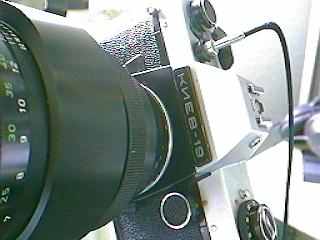
My KIEV19 fixed to the Zeiss lens.
What is the KIEV 19? It is a Russian camera with NIKON bajonet / adaptation. There exist versions with other lens connectors too. It purchased a used camera for DM 70.-. It is absolutely mechanical and in fact I even do not install the battery for the meter. This rugged camera did not fail so far even in -15° C last winter. The movement of mirror inside does shake everything, so in most cases I take images with the old "hat-method". I focuse on a bright star, because the light in the finder is really a bit dark.
Adaptation to my telescopes goes via T2 connectors.
Digital Equipment
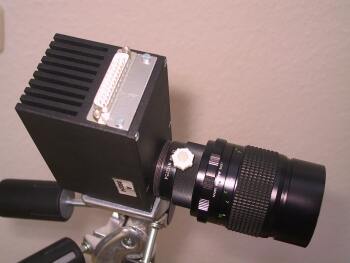
I have a OES AlphaMini Cooled CCD now. Results look promising. I have made a number of images already. I have not used it for a while now, because of not working software.
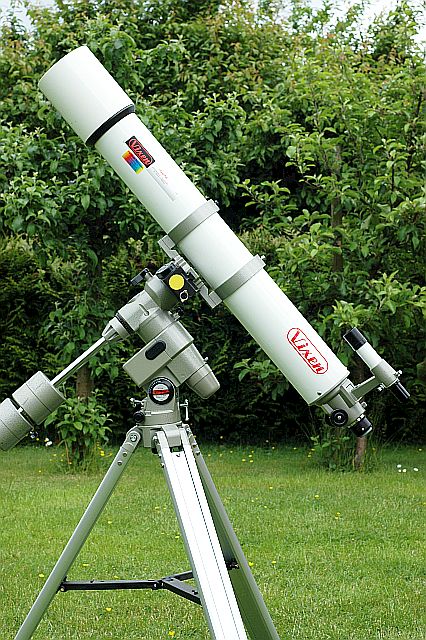
GP 102M - Refractor f/9.8 - 102 mm / f = 1000 mm
In September 2001 I got a refractor, which I would like for the planets and the moon. This refractor is made by VIXEN it is the 102M, a Fraunhofer type. I got it complete with a GP mount. The lens is multicoated and the overall condition of this used scope is excellent.
Meanwhile I had my "first-light" with this refractor. I am very pleased with the sharp and crisp image specially with using the VIXEN LV 20mm eyepiece. I also used my selfmade adapter on the Canon G1 digicam to take first moon shots. Here on the web.
I have excellent results in planetary imaging with this refractor in combination with my webcam.
I have sold this one now
Newton f/5 - 150 mm / f = 750 mm
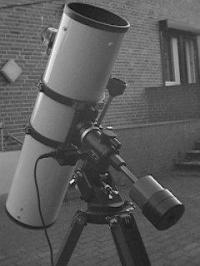
By February 1999 I had the chance to get a Newton type telescope (probably made by MEADE 20 years ago) in a very good shape with a Wachter 8*40 finder mounted. I mounted the thing on my NP mount and had the chance of testing it the same evening in the sky. Yes it clearly outperforms my old R114S, but in an expected range. I do not have the high magnification as before, but after adjusting the two mirrors I see a very good image. So you can believe I am very pleased.
It has become my main instrument and I have had a number of good observing sessions. The telescope is very robust and does not to be re-adjusted very often.
Adjustment is easy and should be done very carefully as it has a short focal length. When done I have an excellent image intra- and extrafocal. This is also proved with high resolution lunar images. I received eMail with congrats from other well known astrophotographers on those images you can see on my lunar webcam pages. I often try magnifications up to 300 with good results.
It sits on my GP mount very sturdy and besides I have the small refractor a guidescope.

Das C8 montiert auf meiner Säule im Garten.
Celestron C8 (orange) mit Zubehör
C8 Baujahr ca 1981. 203mm Durchmesser und f=2000m; also f=10. Nach gelungener Kollimation ein fabelhaftes Gerät. Gerade Planetenaufnahmen in 2005 sind excellent gewordem.
Zubehör:
- Originalgabelmonierung mit Antrieb in Rektaszension (Stundenachse) mit Anschlusskabel 230V.
- Manueller Antrieb für Deklination
- Verstellbare Polhöhenwiege
- Stabiles Stativ mit doppelten (!) Beinen. Dieses steht im Vergleich zu den modernen Geräten außerordentlich stabil und erschütterungsfrei.
- Adaption für ein Leitrohr - speziell Celestron C90. Diese Präzisions Adaption ist verstellbar und erlaubt die präzise Ausrichtung auf einen Leitstern bei Astrofotografie. Ebenfalls kann eine Kamera Huckepack aufgesetzt werden.
- Ausgleichsgewichte und zugehörige Laufschienen für das Leitrohr.
- Adapter: Celestronanschluss auf 1-1/4" mit Gewinde für Teleextender
- Teleextender für obigen Adapter mit T2 Anschluss.
- Adapter: Celestronanschluss auf T2 (ca 5cm lang)
- Biegsame Wellen für Handbetrieb
- 1-1/4" Zenitspiegel
- 1 Okular 30mm Plössl (glaube ich - steht nichts drauf)
- 1 Taukappe. Schwarz.
- 1 Verschlussdeckel.
- 1 Kameraanschluss mit Kugelgelenk; arretierbar.
- 1 kleiner 8*25mm Sucher
- Dazu gehört der Original C8 Transportkoffer (Piratenkiste). Die Beschläge sind allerdings schon leicht angelaufen.
Weiteres passendes Zubehör
Celestron Präzisions Telekompressor / Bildfeldebner; verkürzt das Verhältnis 1:10 auf 1:6.3. Vergütete Optik mit T2 Anschluss beiderseits und ca 5cm T2 Verlängerung.
Celestron Radial Guider mit Verstellbarem Prisma. Der Prismenaussatz kann dazu um ca 135° um die optische Achse rotiert werden. Ein Leitstern ist immer zu finden. Mit dabei ist eine Verlängerungshülse mit 1-1/4" Anschluss zum Ausgleich optischer Wege.
Celestron beleuchtbares Nachführokular Ortho 12.5mm mit Einfachfadenkreuz.
Celestron F/5 400mm refractor (80mm)
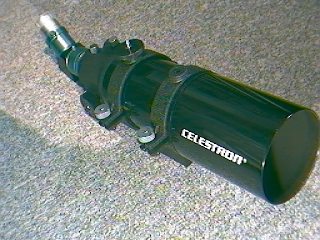
I purchased this 80/400 mm refractor in March 2001 from an internet board for used equipment for little money. When it arrived, I was surprised about the number of parts that came with it. I wanted to have a highly portable refractor which can be mounted on the Newton scope as huge finder scope or guide-scope. The refractor is made in China and looks quite robust. The objetive lens is coated and a T2 ring for photography is included.
The first visual test at roof top (dark/bright) shows some false color with 40* magnification. Inserting an eyepiece of 7 mm shows only little more color. On the evening of 22 March 2001 it cleared and I had a look on Venus. I saw a very nice image with not so much color around than I expected. 57* times magnification with an orthoscopic eyepiece on Jupiter was also very nice showing already details in the atmosphere. This I repeated a few days later - outside - and the visible image is somewhat better than before. Trying out the scope on the moon is a disappointment. I saw strong yellow and blue on the dark/white transits, although the image is very sharp. But it is definitely a widefield scope. With the LcCCD07 I get a field of view of about 22' * 22'. M57 fits just inside the image.
Meanwhile I have this refractor was mounted on my 102M/1000mm refractor as guide scope and large finder. Now it is my guide scope for the Newton.
Eyepieces
Focal length Type Favourite 2.5mm LV 7 mm Ortho 9 mm Ortho 9.7 mm Plössl ** 10 mm Plössl 12.5 mm Ortho * 18.5 mm Ortho *** 20 mm Plössl 20 mm LV ** 25 mm Ortho excellent for projection 25 mm Kellner 30.5 mm Kellner
MOUNT
VIXEN GP on wooden tripod with Skysensor3D controller and homemade LX200 interface for autoguiding. Works perfect !.
Equipment I used to work with
| VIXEN GP102M Refractor (OTA) | 9.2001 .. 11.2005 | Too many scopes. Sold to a friend too. |
| Maksutov 10/1000 | 1995 .. 08.2004 | Did not use it for a long time. Sold to a friend. |
| NIKON F301 Camera | 1997 .. 12.2002 | Sold my F301 Camera to a friend, as I mostly work with my digital Canon G1 today. |
| LcCCD07 Camera | 11.1999 .. 3.2002 | Nice cooled CCD Camera for the beginner with 165*192 pixel resolution. |
| VIXEN New Polaris mount | 2.1998 .. 9.2001 | A good and sturdy mount for the beginner and for travel. I used it with the RA drive. |
| Chinese EQ-5 mount | 10.2000 .. 9.2001 | The EQ-5 is a clone of the VIXEN GP mount. Used from November 2000 to September 2001. See my closer description of this mount in my EQ-5 page. Besides a lot of stuff about the EQ Mount (or Celestron CG-5) you find many interesting stuff at WWW.ASTRONOMYBOY.COM. |
| PENTACON SIX f = 1/4 : 300mm |
11.1998 .. 09.2000 10.2002 .. 05.2004 |
A fine lens for photography. Not so good for astrophotography because of dispersion effects delivering blue halos around bright stars. I had a second one for a while. |
| VIXEN R114S 114/780mm Newton | 02.1998 .. 01.1999 | A very fine scope, which I can recommend. I sold it for the 150/750mm Newton. |
The PURUS tracking clock
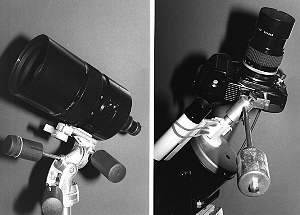 The photo on the left shows my f10/1000mm MCO-AC Maksutov telephoto lens. Here I made it a telescope with a 30.5mm ocular. The right picture shows the mechanical tracking clock from PURUS with the NIKON F90 + f2.8/135mm mounted. |
I used a simple mechanical clock (PURUS Astromechanik) for guiding the camera. Up to now I tried 25 min exposures with a 50 mm lens and 12 min exposures with a 135 mm lens. Operation is a bit tricky, but you can get fine results. Polar alignment is simple with the pole - finder. (If you find the pole through the plastic lenses ...) In February 1997 I constructed a new support tools including new bearings for the clock. You may read more on this clock-tracker and some improvements (in German). This tracking clock is good for the beginner. |